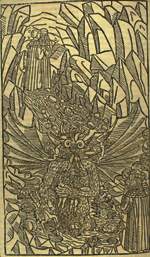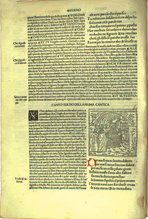1 Dante Alighieri. La Commedia. Florence: Nicolaus Laurentii, Alamanus, 30 August 1481.
In 1481, Dante’s native Florence responded to the several editions of the Divina commedia printed in other cities by commissioning one of its own. In 1302, Dante was exiled from Florence for political reasons with a penalty of death if he were to return. For the remainder of his life, the poet traveled throughout Italy, living under the patronage of prominent citizens. Dante’s real–life exile is mirrored in the Commedia as the character of Dante sojourns through hell.
The text of Cristoforo Landino’s commentary on the Divina commedia—part of the commission mentioned above—appears in print for the first time in this edition, surrounding the text of the poem. Landino (1424–1504), a poet and humanist philosopher under the patronage of Lorenzo de’ Medici, produced his commentary hastily; nevertheless, it became the dominant commentary through the end of the sixteenth century.
The designer of this edition left space for illustrations at the beginning of all but four of the cantos. The extant engravings that fill these spaces are attributed to Baccio Baldini (ca. 1436–ca. 1487) after designs by Sandro Botticelli (ca. 1444–1510). Only nineteen engravings are known to have been completed, and most copies of this edition contain only two or three with the third being a duplicate of the second: the University of Illinois copy follows the latter pattern.

Item 1. leaf a1r
The first engraving depicts events of the first canto of the poem in which Dante enters a dark forest; sees a hill bathed in light; is frightened by a leopard, a lion, and a she–wolf (representing fraud, pride, and avarice, respectively); and meets the Roman poet Virgil, who will guide him through hell.
References: Goff D–29; Harman 316; Mambelli 10
Shelf mark: Incunabula F.851D23 Od 1481
2 Dante Alighieri. La Commedia . Brescia: Boninus de Boninis, 31 May 1487.
This edition is famous for its sixty–eight woodcut illustrations, all but one of which are full–page. Every canto of the Inferno and the Purgatorio, as well as the first canto of the Paradiso, is illustrated. The Brescia Dante, as it is commonly known, is the second illustrated edition of the Divina commedia, following the Florentine edition of 1481 (see Item 1). Stylistically, the first group of nineteen woodcuts in this edition is derived from the Botticelli designs used in the 1481 edition. These, along with the other forty–nine, in turn, provided a model for all subsequent fifteenth–century illustrated editions.
The woodcut for canto 34 of the Inferno depicts Dante and Virgil observing Lucifer as he devours the bodies of Judas, Brutus, and Cassius. The wind produced by Lucifer’s bat–like wings freezes the infernal lake, Cocytus, which is inhabited by the protruding heads of sinners.
References: Goff D–31; Harman 317; Mambelli 12
Shelf mark: Incunabula Q.851D23 Od 1487
3 Dante Alighieri. La Commedia. Venice: Bernardinus Benalius and Matteo Capcasa, 3 March 1491.
Illustrated with 100 woodcuts, this edition contains not only the commentary of Cristoforo Landino, but also marginal glosses to further orient the reader. The text was edited by Pietro da Figino, described in the colophon as “master in theology and excellent preacher of the Order of [Friars] Minor.” Based on textual evidence, some scholars believe this edition was actually printed on 3 March 1492 and that perhaps the printers simply made an error in dating their work because the Venetian new year, at that time, began on 1 March (cf. Cachey, et al.).
The first page of canto 3 of the Inferno includes a woodcut initial S and a rubricated initial P and shows Landino’s commentary surrounding the text of the poem. This is accompanied by a woodcut illustration depicting Dante and Virgil at the gates of hell, with the famed inscription: “Lasate ogni speranza o voi chentrate,” or “Abandon all hope, ye who enter.”
References:Goff D–32; Harman 318; Mambelli 13
Shelf mark: Incunabula Q.851D23 Od1491
4 Dante Alighieri. La Commedia. [Venice]: Vindelinus de Spira, 1477.
The first Venetian edition of Dante’s poem was also the first to be printed with a commentary. In this case, the commentator is Jacopo della Lana (ca. 1278–ca. 1358), a contemporary of Dante. Della Lana wrote his commentary sometime after Dante’s death, but before 1328. It is considered among the best of the early criticisms along with those of Benvenuto da Imola, Guido da Pisa, and two of Dante’s three sons, Jacopo and Pietro. In this edition, however, the colophon incorrectly attributes della Lana’s commentary to Benvenuto da Imola, perhaps to increase sales through name recognition (cf. Cachey, et al.).
This edition also contains the first printing of Giovanni Boccaccio’s Vita di Dante, or Life of Dante. Boccaccio (1313–1375), who was only eight years old when Dante died, was among the first of the poet’s defenders to extol his virtues through a combination of commentary, teaching, and textual editing. Attempting to reclaim its exiled native son, the City of Florence commissioned Boccaccio to deliver a series of lectures on Dante beginning in 1373.
References:Goff D–27; Harman 315; Mambelli 7
Shelf mark: Incunabula Q.851D23 Od.la 1477
5 Dante Alighieri. La Commedia. Venice: Petrus de Quarengiis, Bergomensis, 11 October 1497.
The text and woodcuts of the final fifteenth–century edition of the Divina commedia are resettings–with some modification–of the 1491 edition of Pietro da Figino (see item 3). This reprinting demonstrates how strong the market was in Venice for scholarly editions of the poem.
References:Goff D–35; Harman (Suppl.) 13; Mambelli 16
Shelf mark: Incunabula Q.851D23 Od 1497


